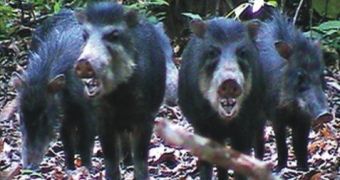These are the New World's native wild boars: the peccaries. And till now, the largest pig-like species have stood hidden from scientists in the southeastern Amazon region of Brazil.
It is the largest peccary in the world, about the size of a large dog.
The new species, the forest giant peccary (Pecari maximus) was discovered first in 2004 in the basin of the Rio Aripuan? and recent DNA analysis made at the Leiden Centre for Environmental Sciences in the Netherlands, confirmed the individuals belonged to a distinct species, as published last week in the journal Bonner zoologische Beitrage. Local Tupi Indians knew well the creature that they called Caitetu Munde ("great peccary which lives in pairs").
"One day I was looking at some monkeys, and I saw three peccaries pass in front of me totally silent. They appeared and then disappeared without making any noise." Dutch biologist Marc van Roosmalen of the University of Leiden told LiveScience.
"Later, I asked the locals what I had seen. It shows that you really have to see things and then ask people what you've seen. They are not going to tell you otherwise. It's normal to them. It turns out to be their most hunted animal."
Peccaries are hoofed animals resembling pigs, but with some advanced traits, like 1-2 offspring in a litter and compartmented stomach. Peccaries are much smaller than the boars, weighing 20 and 30 kilograms (44 to 70 pounds), but the new species seems to reach 40 kg (88 pounds). Until now, just three species have been discovered: the collared peccary, the white-lipped peccary and the Chaccoan peccary (the last was first described based on fossils and later discovered alive in 1975!).
Peccaries are extremely aggressive; they usually live in packs of tens to hundreds and attack predators in groups, inflicting severe wounds with their long sharp canines. This way they kill even jaguars and humans.
"Measurements of the new peccary's body and skull confirm that the new species is larger than the other peccary species. The giant peccary has longer legs and its fur markings are completely different," said van Roosmalen.
Unlike other peccaries, the new giant lives in pairs or small family groups made by the parents and 1-2 offspring. And while other peccary species, just like pigs, root in the ground for seeds and roots, the new species feeds mainly on fruit, being less addicted to rooting.
"The giant peccary has a gland that is active in other peccary species and used to mark territories as well as each other. However, the new peccary is scentless. I think it's another adaptation to predation pressure from big cats. Through evolution, they cannot afford to be so stinky as the other ones." said van Roosmalen.

 14 DAY TRIAL //
14 DAY TRIAL //